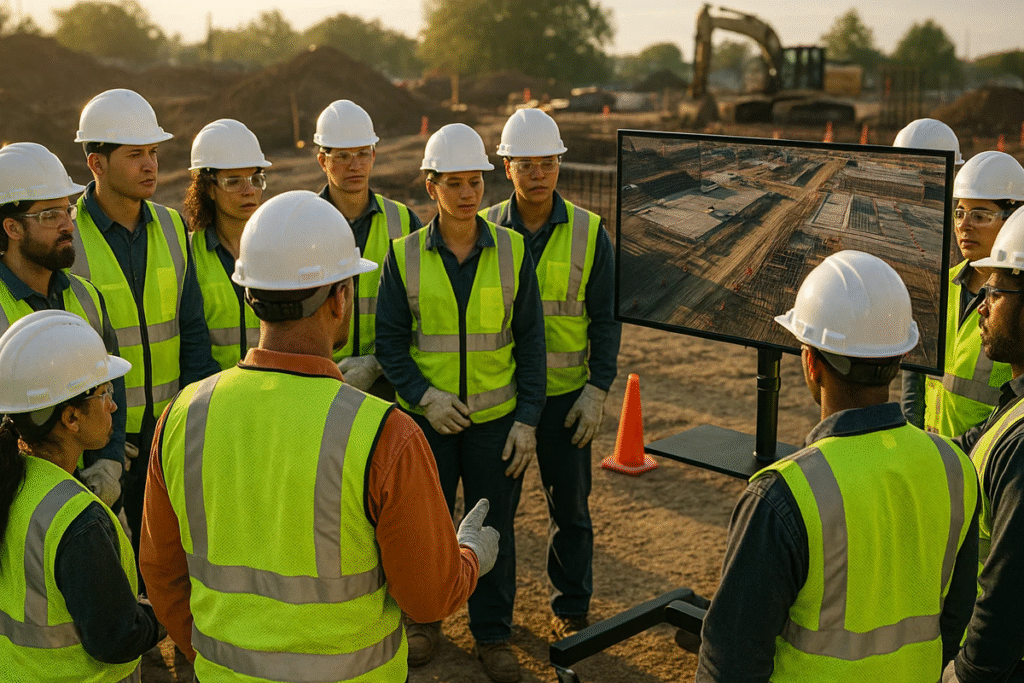
Leveraging Drone Footage for Site-Wide Safety Briefings

Drone video turns a complex job site into a clear, shared picture. Used inside daily briefings and orientations, high-angle visuals help crews see traffic conflicts, blind corners, fall exposures, and egress routes before work begins. That visibility matters: the United States recorded 5,283 work fatalities in 2023 and transportation incidents remained the leading event, accounting for 36.8% of deaths, underscoring the value of better pre-task awareness across sectors (U.S. Bureau of Labor Statistics, 2024).
To keep your “drone safety briefing” program compliant and defensible, align flight operations with the FAA’s Small UAS Rule. Part 107 requires a certificated remote pilot and sets operating rules; recent FAA rules permit routine operations over people and at night under specific conditions; Remote ID is now the default identification framework; and airspace approvals in controlled airspace are often automated through LAANC. These foundations let you gather footage lawfully, then use it for toolbox talks and safety training (Small Unmanned Aircraft Systems, 2025); (Federal Aviation Administration, 2022); (FAA, 2025a); (FAA, 2024); (FAA, 2025b).
Construction teams use aerial clips to brief crane swing radii, excavation edges, and roof work zones, reducing exposure during inspections a benefit supported by DOT research on bridge inspections with UAS (Cheyne et al., 2019). Rail and roadway operators can brief grade-crossing risks and sight-line issues using drone-derived 3D data, improving transportation safety meetings (Federal Railroad Administration, 2020). General industry orientations gain from a true overhead “worksite analysis,” advancing the employer’s duty to abate recognized hazards under the OSH Act’s General Duty Clause (Occupational Safety and Health Administration, n.d.-b). Environmental and emergency teams use UAS imagery to brief spill paths, flood routes, and exclusion zones; EPA’s UAS program and FEMA’s guidance emphasize safety, cost, and environmental advantages of drone-derived imagery (Greene & Homsher, 2023); (Department of Homeland Security, Federal Emergency Management Agency, 2020).
The strongest programs connect drone footage to OSHA’s four pillars. Use clips in safety and health training to make hazards tangible; apply them to hazard prevention and control by planning barricades and routes; treat flights as part of routine worksite analysis; and invite workers to narrate footage during briefings to deepen management commitment and employee involvement (OSHA, n.d.-a). Short “over-people” shots must still meet FAA category limits, and every briefing stays anchored to OSHA’s construction training requirement to instruct employees in hazard recognition and avoidance (FAA, 2022); (OSHA, 2015). For additional context on benefits and cautions, NIOSH notes drones can reduce fall and struck-by exposures when risks are managed (Howard et al., 2017).
Key Safety LLC can build the entire system: Document Development for Start-up Projects to craft your Part 107 SOPs, privacy language, and briefing scripts; Service on Demand for rapid flight-plan and LAANC checks; and Regular Consultation Service to coach supervisors on integrating drone footage into daily talks and new-hire orientations. Subscribe to our newsletter for practical templates and case studies that keep your program current and compliant.
References
Howard, J., Murashov, V., & Branche, C. (2017, October 23). Drones on the construction site. NIOSH Science Blog. https://blogs.cdc.gov/niosh-science-blog/2017/10/23/drones-construction/
Department of Homeland Security, Federal Emergency Management Agency. (2020, May 27). Privacy Impact Assessment for FEMA response use of unmanned aircraft system (UAS) derived imagery (DHS/FEMA/PIA‑055). https://www.dhs.gov/sites/default/files/publications/privacy_pia_fema_055_uas_may2020_0.pdf
Standard for Small Unmanned Aircraft Systems, 14 C.F.R. § 107 (2025). https://www.ecfr.gov/current/title-14/chapter-I/subchapter-F/part-107
Greene, A., & Homsher, R. (2023, February 8). Unmanned aircraft systems (UAS) EPA handbook. U.S. Environmental Protection Agency. https://www.epa.gov/system/files/documents/2023-04/EPA%20UAS%20Handbook.pdf
Federal Aviation Administration. (2022, November 10). Operations over people general overview. https://www.faa.gov/uas/commercial_operators/operations_over_people
Federal Aviation Administration. (2024, December 5). UAS Data Exchange (LAANC).https://www.faa.gov/uas/getting_started/laanc
Federal Aviation Administration. (2025, March 19). Remote identification of drones.https://www.faa.gov/uas/getting_started/remote_id
Federal Aviation Administration. (2025). Certificated remote pilots including commercial operators.https://www.faa.gov/uas/commercial_operators
Federal Railroad Administration. (2020, August 24). An automated, drone‑based inspection system (RR 20‑14). U.S. Department of Transportation. https://railroads.dot.gov/elibrary/automated-drone-based-inspection-system
Cheyne, D., Merrill, B., & Boggs, J. (2019). Use of small unmanned aerial systems for bridge inspection (Report No. FHWA-HIF-19-056). U.S. Department of Transportation, Federal Highway Administration. https://railroads.dot.gov/elibrary/automated-drone-based-inspection-system
Occupational Safety and Health Administration. (n.d.-a). Recommended practices for safety and health programs.https://www.osha.gov/safety-management
Occupational Safety and Health Administration. (n.d.-b). Occupational Safety and Health Act of 1970, Section 5 – Duties.U.S. Department of Labor. https://www.osha.gov/laws-regs/oshact/section5-duties
Standard for Safety training and education 29 CFR § 1926.21 (2015). https://www.osha.gov/laws-regs/regulations/standardnumber/1926/1926.21
U.S. Bureau of Labor Statistics. (2024, December 19). National census of fatal occupational injuries in 2023 (USDL-24-2564). U.S. Department of Labor. https://www.bls.gov/news.release/pdf/cfoi.pdf
Comments:

